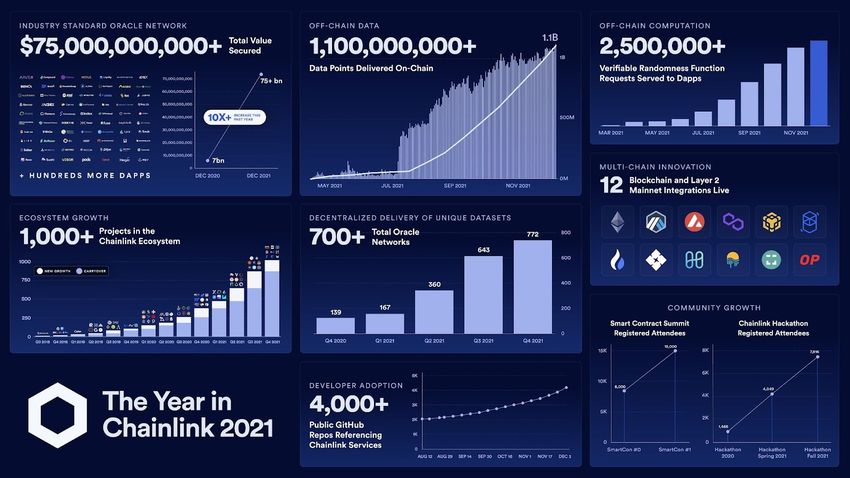The Chainlink (LINK) ecosystem experienced exponential growth in 2021. The project has published a list of achievements for the past year and indicated its development outlook for 2022. The most important events are expected to be the launch of LINK staking and the release of CCIP.
According to a recently published report, the previous year was a record year for Chainlink on many levels. The most popular oracle network (oracles) has already surpassed more than 1,000 integrations, secured more than $75B TVS (total value secured), and delivered secure off-chain computing through the use of DON (Decentralized Oracle Networks).
SponsoredFurthermore, Chainlink protocols are used by many of the most popular blockchain networks such as Avalanche (AVAX), Binance Smart Chain (BSC), Ethereum (ETH) and Polygon (MATIC). What’s more, dominant global business brands have decided to run their nodes on the network to access trusted and verified data from a variety of sectors. These include The Associated Press, AccuWeather, Amazon Web Services, Google Cloud Platform or Swisscom.
Chainlink grows in 2021
One of the most impressive findings from Chainlink’s 2021 report is the year-on-year increase in TVS. At the start of 2021, the network was securing around $7 billion, only to increase that number 10 times 12 months later. Today, Chainlink oracles secure more than $75B. This gives the network second place in the entire DeFi ecosystem.

Another success story for the largest oracle network is the number of partnerships and integrations. In December, it crossed the barrier of 1,000 projects that use off-chain data provided by Chainlink in their hybrid smart contracts. In addition to DeFi’s core areas, oracles secures value in many other sectors. As the report states:
“Chainlink is also being used to secure value across a number of additional innovative DeFi use cases such as algorithmic stablecoins, decentralized exchanges, prediction markets, payment networks, insurance platforms, asset management protocols, and more.”
Since mid-2021, there has also been a huge increase in Verifiable Randomness Function (VRF) access requests – over 2.5 million – and data points delivered on-chain – over 1.1 billion. In this way, VRFs and so-called Chainlink Keepers have extended support to more blockchains, providing developers with access to a secure source of verifiable randomness.
SponsoredOutlook for 2022
In a new 1.5-hour video titled ‘The Future of Chainlink,’ Sergey Nazarov, co-founder of Chainlink outlined the development plans for the coming year. During the presentation, he explains the need for deterministic cryptographic truth versus the current system of probabilistic paper-based guarantees. In addition, he broadly describes how Chainlink is facilitating what he believes is a key societal transition.
Commenting on the presentation, popular Chainlink community ambassador, @ChainLinkGod tweeted the 3 most important initiatives for the project’s development in 2022. These are, in his opinion:
- Release of CCIP
- Release of LINK staking
- Chainlink as an abstraction layer for enterprises
Cross-Chain Interoperability Protocol (CCIP) is an open-source standard for secure cross-chain messaging. It enables programmable token bridges and cross-chain applications that can send tokens and commands between blockchains and Layer 2. For example, Celsius, a leading CeFi platform, has announced that it will use CCIP to generate revenue across its multi-chain ecosystem. As the report reads:
“CCIP will provide smart contract developers with generalized, compute-enabled infrastructure for transferring data and commands across public and private blockchains.”
Next, LINK token staking is a long-awaited feature of the Chainlink network. It is expected to enhance the cryptographic and economic security of the oracle network. LINK will be blocked as a security measure to generate revenue from user fees, which can be reduced in the case of malicious nodes.
Finally, the last point highlights the importance of Chainlink for global enterprises that will integrate with blockchain networks. The introduction of the abstraction layer means that businesses can connect their backend system to any blockchain through a single integration. This will allow any business to generate new revenue streams and mitigate counterparty risk through direct access to smart contracts.
What do you think about this subject? Write to us and tell us!

